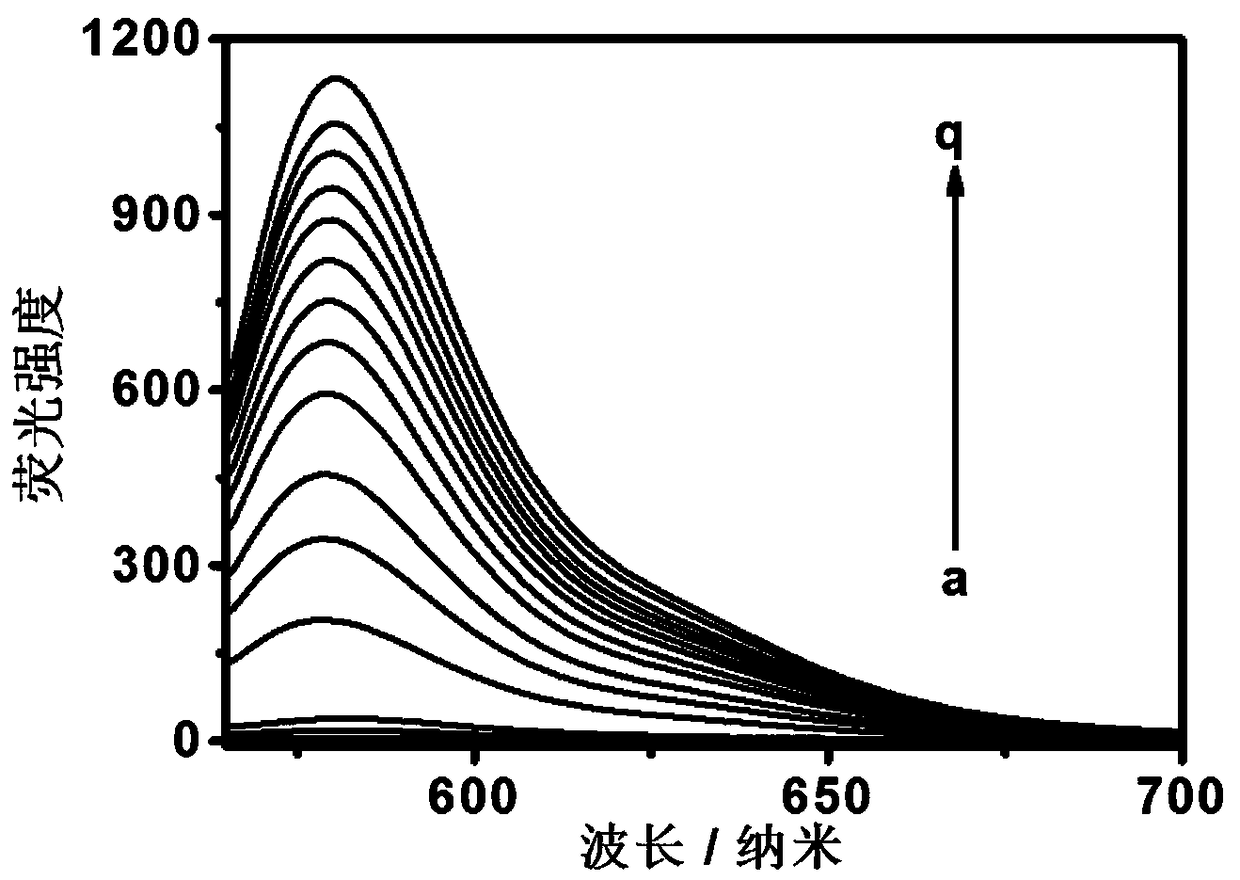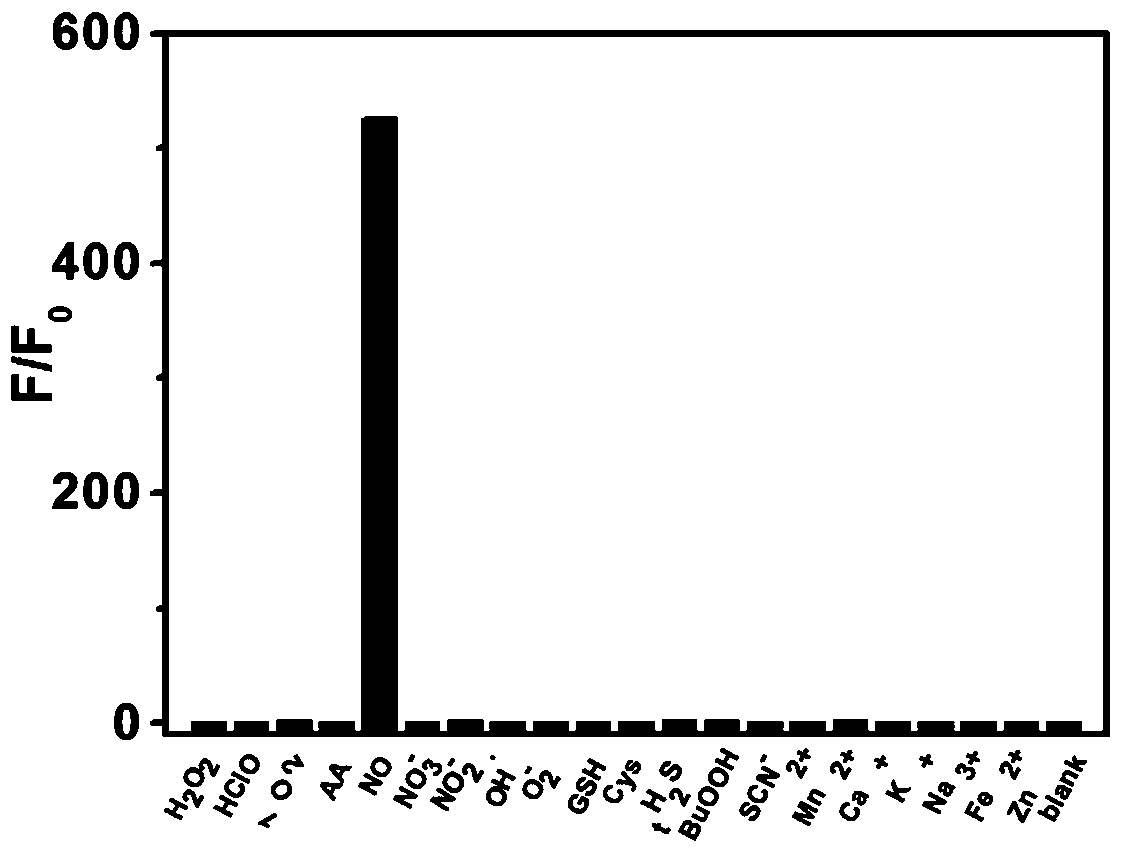A water-soluble fluorescent probe for detecting nitric oxide in liver cells and its application
A fluorescent probe and nitric oxide technology, applied in the fields of analytical chemistry, life science and medicine, can solve the problems of inability to specifically identify cell tissue, poor water solubility, toxic side effects, etc., and achieve convenient post-processing, low cost input, and synthetic simple route effect
- Summary
- Abstract
- Description
- Claims
- Application Information
AI Technical Summary
Problems solved by technology
Method used
Image
Examples
Embodiment 1
[0024] A preparation of a water-soluble fluorescent probe for detecting nitric oxide in liver cancer cells, comprising the following steps:
[0025] (1) Preparation of product 1.
[0026] Add 4-amino-3 nitrophenol (3.0 mmol) into 20 mL of acetone, then add propyne bromide (4.5 mmol), stir well and then add K 2 CO 3 (6.0 mmol). Heat to reflux for 14 hours. Stop after the reaction is finished, filter, wash with dichloromethane for 3-4 times, then concentrate and filter the filtrate with a rotary evaporator, and then pass through the column with silica gel chromatography to obtain the product 1.
[0027]Product 1 (1.2 mmol) was dissolved in 1,4-dioxane (15 mL), then stannous dichloride dihydrate (1.35 g, 6.0 mmol) and concentrated hydrochloric acid (3.0 mL )mixture. After the dropwise addition of the mixed solution was completed, the reaction was carried out at room temperature for 48 hours. After the reaction is complete, neutralize the reaction solution to neutrality wit...
Embodiment 2
[0033] Embodiment 2: detection experiment of nitric oxide.
[0034] Take 17 5mL sample bottles, respectively add 3 mL of the solution prepared by the fluorescent probe obtained in Example 1 (the concentration of the fluorescent probe is 5 μM, and it is prepared with an aqueous solution with a pH of 7), and then respectively add the solution with a concentration of [NO ] = 0(a), 5×10 -3 mol / L (b), 1×10 -2 mol / L (c), 1.5×10 -2 mol / L (d), 2×10 -2 mol / L(e), 2.5×10 -2 mol / L(f), 3×10 -2 mol / L (g), 3.5×10 -2 mol / L (h), 4×10 -2 mol / L(i), 4.5×10 -2 mol / L(j), 5×10 -2 mol / L (k), 5.5×10 -2 mol / L (l), 6×10 -2 mol / L (m), 7×10 -2 mol / L (n), 8×10 -2 mol / L(o), 9×10 -2 mol / L (p), 1×10 -1 mol / L (q) of 3 μL nitric oxide solution was added to 17 sample vials, stirred at room temperature for 10 min, and the fluorescence intensity of these samples was measured with 550 nm as the excitation wavelength, and the fluorescence emission of 17 samples was obtained. Spectral c...
Embodiment 3
[0035] Example 3: Selective detection experiment of other ions and peroxide influence.
[0036] Take 18 5 mL sample bottles and fill them with 3 mL of the fluorescent probe solution obtained in Example 1 (the concentration of the fluorescent probe is 5 μM, which is prepared with an aqueous solution with a pH of 7), and then respectively add the fluorescent probe solution with a concentration of 5.0× 10 -2 mol / L (H 2 o 2 , HClO, 1 o 2 , AA, NO, NO 3 - , NO 2 - , OH . , GSH, Cys, CNS - , Mn 2+ 、Na + 、K + , Zn 2+ , Fe 3+ , Ca 2+ ) and add 3µL each to the other first 18 sample vials, and sample No. 18 is the blank sample. Then measure the fluorescence emission intensity at 550 nm wavelength excitation and 580 nm wavelength emission of 18 samples respectively, the results are shown in image 3 . The measurement results show that, except nitric oxide, other above-mentioned ions and peroxides have no obvious influence on the fluorescence intensity of the prepared f...
PUM
 Login to View More
Login to View More Abstract
Description
Claims
Application Information
 Login to View More
Login to View More - R&D
- Intellectual Property
- Life Sciences
- Materials
- Tech Scout
- Unparalleled Data Quality
- Higher Quality Content
- 60% Fewer Hallucinations
Browse by: Latest US Patents, China's latest patents, Technical Efficacy Thesaurus, Application Domain, Technology Topic, Popular Technical Reports.
© 2025 PatSnap. All rights reserved.Legal|Privacy policy|Modern Slavery Act Transparency Statement|Sitemap|About US| Contact US: help@patsnap.com



